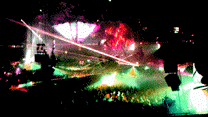|
|



Humans want to remember. But history as a database is a very incomplete story with big holes.Humans have an extremely strong urge to shape. Until very recently, words and writing have been our easiest ways to encode data, which through the knowledge of past and present were meant to guide us more intelligently into the future. But a large number of artistic creations have been lost due to storage difficulties.
In the beginning through oral tradition, later through writing and painting, books, and finally through mass media, through records, CDs, CD-ROMs and databases in the Net. Are these tools changing the way our brains process data?Words describe, are almost never exstatic in their written form or their sound. Words as language become exstatic when used in a fine-tuned way, in the form of song.
Songs are a combination of words and sounds, made by humans, dolphins, squeaking doors or the wind, etc. Songs are combined with other musical instruments to become music.Taking the next step by only shifting from analog to digital we start speaking of Techno - any songs and sounds can be sequenced and mixed digitally by means of sampling technology. Using sampling technology, techno music was the first exstatic digital music movement, starting with House, Acid, Electronic Body Music, up to the many faces of techno like Trance, Ambient, Gabba, Intelligent, Jungle, Psychedelic, Electro, Trip-Hop and whatever is being created right now.
 right now.
right now. 
Amigas 3000 and 4000 become cultfetishes like Roland 808 or 202 - like it is happening in Japan at the moment.All these machines give the human brain the possibility to connect to much data, perhaps exstasy, reminding us of a state of being past, present and future at the same time, a state which enables us to collectively switch to a different kind of communication we call

